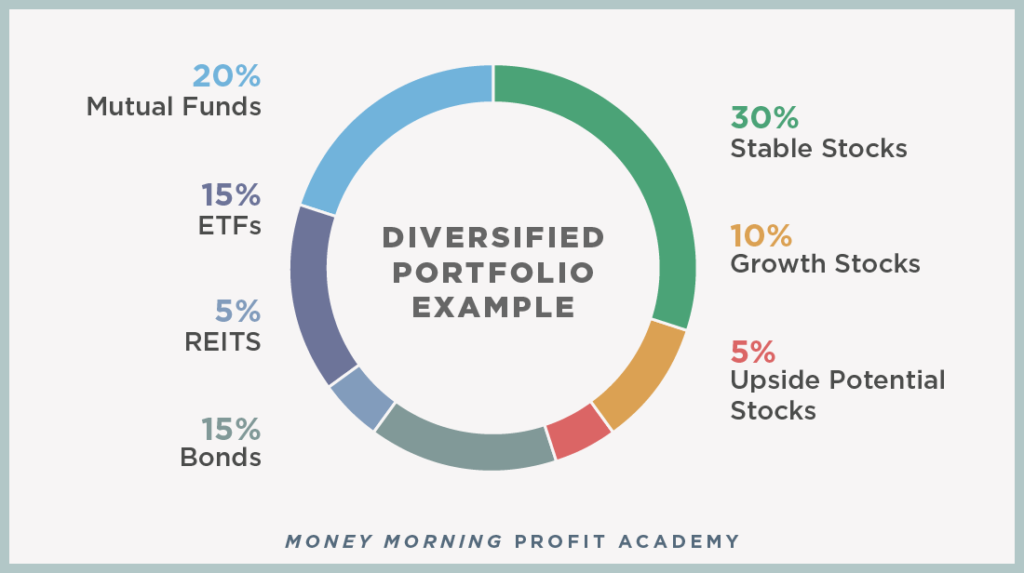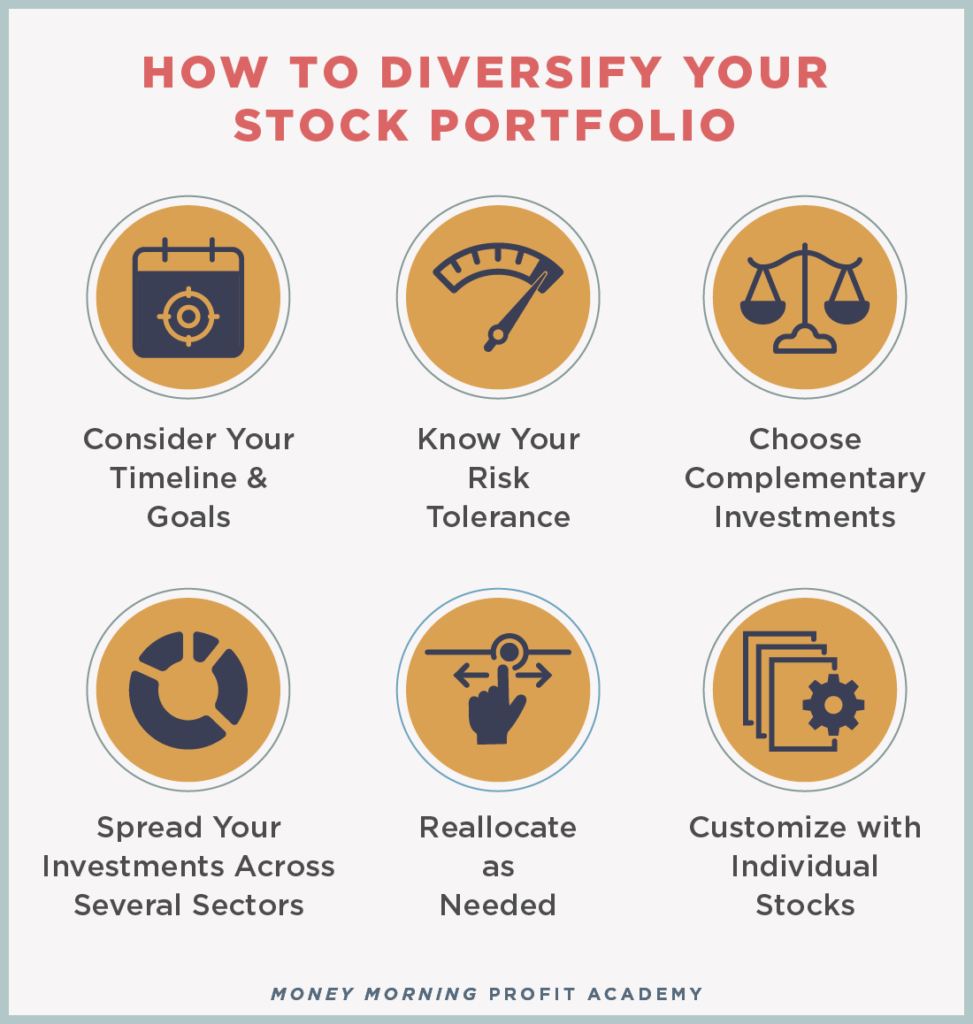
A suggestion you’ve probably heard many times is to have a “diversified stock portfolio.” But what does that mean and how do you successfully diversify to warrant greater returns?
Here, we break down diversification and explain what a diversified portfolio looks like. We also cover how to diversify your portfolio correctly so you can limit the downsides without limiting your profits.
What Is a Diversified Stock Portfolio?
A diversified stock portfolio contains various stocks and assets from different sectors and types of companies. The goal of diversification is to warrant higher returns even through market fluctuations.
Essentially, diversification means not putting all your eggs in one basket.
How Does Stock Diversification Work?
Stock diversification works by balancing your investments to align with your goals and risk tolerance. It refers to the practice of investing in several different avenues to protect against market fluctuations. Stock diversification works when you invest in several assets, not just a select few.
Building a stock portfolio helps balance stability and growth and maximize returns. To make diversification work, your investments should be based on your goals and risk tolerance. This allows you to diversify your portfolio accordingly.
For example, if you don’t mind taking some risk in your portfolio, you can invest in riskier stocks, such as IPOs, startups (even before they go public), or breakout sectors like legal cannabis.
These plays might carry the most risk, but they can also have the potential to increase your investment performance if they work out. But you will also have foundational stocks to help balance out your portfolio.
What Should Be in a Diversified Stock Portfolio?
When building your portfolio, you might wonder what stocks make up a diversified portfolio. The answer depends on your level of risk and financial goals. In the next few sections, we’ll highlight investment types you may want to consider in your diversified stock portfolio: stable stocks, growth stocks, and upside potential stocks.

Stable Stocks
When we talk about “stable stocks,” we’re really talking about companies that offer you protection against market downturns. In our previous lesson on how to make money in the stock market, we discussed that companies trading at value prices pay off when you hold them over the long term. These will help form the most stable part of your portfolio.
Take Becton Dickinson & Co. (NYSE: BD) for example. On the surface, this medical device company might not seem like the most exciting investment. But when you consider that we need more healthcare services as we age, you can see the potential for this company to weather any storm.
Growth Stocks
Growth stocks are companies in some of the hottest sectors that are constantly reinvesting in themselves to stay on top of the market. That means they are less likely to pay a dividend and their shares can be more volatile in the short term, but their growth potential makes it all worthwhile.
When looking for growth stocks, keep your eye for businesses that:
- Have increased their revenue and earnings at a faster rate than average
- Have developed a new or unique product or service that’s gaining popularity
- Have entered new markets (or created a new market themselves!)
One example of a growth stock would be Shopify (NYSE: SHOP). Shopify is an e-commerce website and application that allows businesses to easily build an online store without expertise in web design or e-commerce. According to Acquire Convert, Shopify currently has almost 20% of the market share of e-commerce sites and has a 183% compound annual growth rate. A growth stock like Shopify has grown fast for a long period and still has the potential to deliver huge returns for investors.
Upside Potential Stocks
Upside potential stocks are stocks that are just in their infancy but have the potential to deliver hugely. These stocks bring the most risk, but also the most potential reward, such as IPOs, startups, or breakout sectors. One example of an upside potential stock could be a stock in the legal cannabis sector.
If you bought into one of our favorite cannabis stocks in 2016, you’d have seen over 2,000% peak gains. While growth stocks show sustained growth over a few years, upside potential stocks are just beginning their massive uptick.
Of course, not every one of these plays works out, which is why you don’t build your portfolio around them. But setting aside a small part of your portfolio for these opportunities is the difference between an average portfolio and a great one.
Other Investment Options for Your Diversified Stock Portfolio
In addition to the stable, growth, and upside potential stocks to diversify your portfolio, there are also many other types of stocks and investments that can help. Here are a few:
Bonds
Bonds aren’t technically a stock but are included in the list because they can be used to diversify your portfolio. They are fixed-income instruments that represent a corporate or governmental loan.
Real Estate Investment Trusts (REITs)
REITs are kind of like investing in real estate without all the headaches of managing a property. They are a group of funds that represent real estate investments and companies that own, operate, or finance income-generating real estate.
Exchange-Traded Funds (ETFs)
Exchange-traded funds, or ETFs, are a collection of stocks that track a certain index, such as the S&P 500. They represent a “bucket” of stocks that are all lumped in together.
Mutual Funds
Mutual funds are stocks that represent small pieces of many different companies in a single “stock.” Because they are also a bucket of different stocks, they’re more diverse than individual stocks (but they also generate more modest returns).
Of course, there are other types of investments altogether, such as gold, real estate, fine art, and more. But the focus here is on helping you diversify your stock portfolio more specifically.
How to Diversify Your Stock Portfolio
Now that you understand the importance of having a diversified stock portfolio, and all the components that go into one, let’s look at some tips to help you diversify your portfolio.

1. Consider the Timeline for Reaching Your Goals
One of the most important things you should do before even considering specific stocks is to look at your goals and establish a timeline for your short, medium, and long-term goals. A long-term goal, such as retirement, will require a different asset allocation than a short-term goal, such as making a few thousand dollars within the month.
With your long-term goals, you have more time to let assets appreciate and grow to significant amounts. You can also ignore day-to-day volatility because you're not intending to sell any time soon. With short and medium-term goals, you might have to choose investments or trades that are higher risk than the slow-growing long-term investments, because they can return a higher percentage in a faster timeframe.
You should also consider how liquid you want your assets. Assets tied up in a 401(k) can’t be easily liquidated because they’re designed for retirement, but assets invested in a discount brokerage or robo-platform can be in your bank account in a matter of days.
2. Know Your Risk Tolerance
In addition to knowing your goals and their timelines, you should also know your risk tolerance, or how much fluctuation in investment returns you can withstand. Your portfolio diversification will be unique to how much risk you’re willing to take and will differ from your friends, family, and mentors. Make sure your portfolio and risk tolerance are aligned to avoid any surprises.
Typically, you don't want to invest money you truly can't afford to lose, as there's no guarantee you will get it back.
3. Choose Complementary Investments
The best-diversified stock portfolios consist of asset classes that have minimal negative correlations, which means that when one is up, the other may be down and vice versa.
What you don’t want are two stocks that mirror each other, so they are both up and down at the same time. This would defeat the purpose of diversification because if all of your investments are down, you’re not protecting your assets against market fluctuations. Typically, you don't want to invest money you truly can't afford to lose, as there's no guarantee you will get it back.
4. Spread Out Your Investments
As we mentioned, one of the key components of portfolio diversification is spreading your investments across several sectors, including companies of different sizes and industries. You can also consider spreading your investments throughout the options we listed above.
This method of diversification is important because different investments will perform differently and when you spread your eggs (or stocks) into many different baskets, you don’t sacrifice your whole portfolio when one investment goes down.
5. Reallocate as Needed
Your diversified stock portfolio shouldn’t be a “set it and forget it” type of thing. You need to be actively managing its performance and adjusting as needed. For example, if you made some major gains from your upside potential stock, you could consider reinvesting that capital in some of your stable stocks to build a stronger base.
6. Customize with Individual Stocks
Customizing with individual stocks is what makes an otherwise average portfolio a great portfolio. By diversifying your portfolio with individual stocks, you can dramatically increase your profitability while keeping your risk in check. That gives you the upside potential you’ll need to hit your retirement goals without being weighed down by owning unreliable companies in weak sectors as other diversification strategies would have you do.
The Importance of Diversification
Now that you understand what it means to diversify your stock portfolio, what that looks like in practice, and how you can both protect against losses and not sacrifice your gains, it’s time to dive deeper into investing strategies.
Continue to the next lesson, where we discuss our favorite structure for portfolio diversification.


